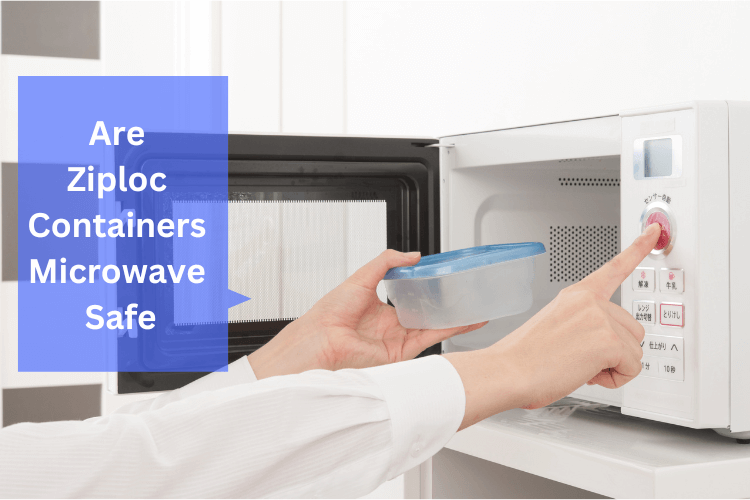Step into any kitchen, and you’ll most likely come across a plastic container. They are indispensable in any kitchen. If not for storing your food, you’ll use them to reheat food before serving your loved ones.
If you’re into cooking, you already know that not all plastics are safe to use in a microwave.
Are Ziploc containers microwavable? Can you put a Ziploc container in the microwave? Is it safe to microwave a Ziploc container?
Ziploc containers are microwave safe. They are specially manufactured for safe microwave use. In fact, they usually come with a microwave-safe label.
The label shows that the containers have met the FDA’s safety requirements for reheating food in the microwave. They have been tested and proven not to melt under high temperatures from the microwave.
Can You Microwave Food in Ziploc Containers?
Yes, you can microwave food in a microwave-safe Ziploc container.

Most Ziploc container plastics don’t contain chemical dioxin; thus, they are microwave safe. These containers are also BPA-free and fully recyclable.
Check the website brand before using any Ziploc container if you need more assurance. It’s the only way to find out how safe the dish is in the microwave.
It’s also from the website that you’ll get a chance to take a closer look at the instructions for proper use.
When reheating your food in a Ziploc container, ensure that you vent it as the steam can cause a terrible mess.
Microwaving a Ziploc Container – Health Risks
You must have heard horror stories about the risks to human health from plastics. BPA is a common chemical used in plastics and has been linked with health effects such as cardiovascular disease and endocrine disorders.
The biggest concern about BPA is that it can leach to your food when the plastic is heated.
What of Ziploc containers? Do they pose any health risk when heated or warmed? Remember, they are also made from plastic!
The trick with Ziploc containers is using them as instructed by the manufacturer, i.e., to reheat or defrost food. Use the containers in the 2 ways, and you won’t have to worry about health risks associated with microwaving them.
Ziploc containers are BPA-free as they are made from linear low-density polyethylene plastic (LLDPE) and low-density polyethylene plastic (LDPE).
However, if a Ziploc container doesn’t come with a microwave-safe label, refrain from using it in the microwave as it can melt and leach chemicals into your food.
Can You Cook in a Ziploc Container?
You should never cook in a Ziploc container.
Cooking involves high temperatures that can surpass the melting point of polypropylene plastic. It’s for this reason that Ziploc is only recommended for defrosting and reheating.
You should also never consider steaming your veggies in a Ziploc container. The heat transfer rate of steam is higher than physical contact with hot (boiling) water.
Steaming foods in a Ziploc container creates a higher temperature than polypropylene plastics can tolerate.
At What Temperature Can a Ziploc Container Melt?
Ziploc containers are made from polypropylene plastic, with a melting point of 160 degrees C or 320 degrees F.
These containers can therefore withstand the temperature of hot food. You should, however, never use them in a conventional oven.
And how long should you microwave a Ziploc container? Always microwave the containers on medium to low power using 1-minute increments.
Ensure that the container is vented to prevent steam buildup. It would be best if you also examined the container after every minute to confirm that it’s not overheating.
Are all Ziploc Containers Microwave-Safe?
Ziploc containers are microwave safe as they are BPA and dioxin-free. When exposed to moderate heat, they don’t leach any chemicals into your food.
These containers have undergone toxicity and safety testing and are deemed compliant with all applicable quality and safety laws.
Things to Note before Using a Ziploc Container in a Microwave
- You can only defrost, reheat and not cook in a Ziploc container.
- Ziploc containers, although microwavable, can’t withstand high temperatures. Microwave them on low to medium power settings.
- Pay special attention when microwaving food rich in fat and sugar content as they heat up to high temperatures making your container overheat.
- Always place your Ziploc containers on a heatproof microwave-safe tray before placing them in the microwave.
- The container should be ventilated to prevent the buildup of steam and pressure.
- When heating edibles in a Ziploc container, cut them into small pieces to allow them to heat evenly and faster. Reduced heating time reduces the risk of overheating.
- Sauces such as spaghetti sauce should only be added in the last few seconds of cooking, as they tend to heat up faster.
- Always go through the manufacturer’s instructions on the best way to use the Ziploc container.
Conclusion
Ziploc containers are microwave safe and can help you reheat or defrost food in the microwave. You should, however, never use them for microwave steaming or cooking.
The polypropylene plastic that these containers are made of can only stay stable for short periods of mild heat. When exposed to high temperatures for long, they can warp or melt and leach chemicals into your food.
Use 1-minute increments on low to medium power settings when reheating food in the microwave using a Ziploc container.
And although all Ziploc containers are dioxin-free and BPA-free, it’s advisable that you follow the manufacturer’s guidelines when microwaving them.
